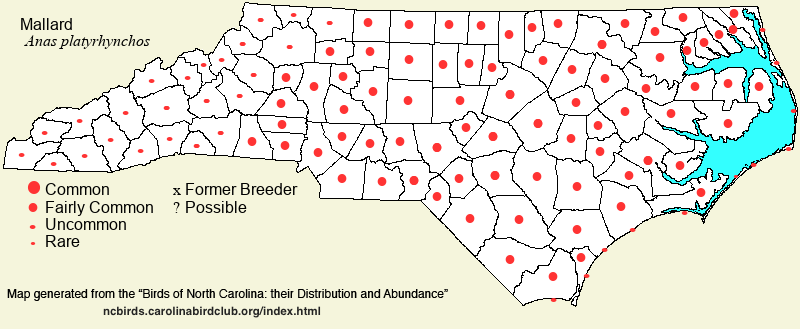 |  |
|
Mallard - Anas platyrhynchos ANATIDAE Members: | Search Common: Search Scientific: |
|
|
|||||||
| General Comments | The overly familiar Mallard used to be only a winter resident in NC, except as "accidental" nesters. However, feral populations are now breeding essentially statewide. These feral populations make it difficult to determine what percentage of birds seen in the cooler months are "legitimate" migrants from native breeding populations farther north. At any rate, numbers of Mallards are increasing in all parts of the state, though it is not clear if the native population wintering in the state is increasing or not. Mallards breed in fresh marshes surrounding lakes, ponds, beaver ponds, impoundments, open swamps, etc.; however, they tend to avoid nesting in brackish marshes. In winter and in migration, the species occurs on bodies of fresh water of almost any size, including smaller farm ponds; they can be common in some swamps, as well as open water far from forests. It is our most widespread dabbling duck, at all seasons, in terms of range and habitats; however, it is outnumbered by several other puddle ducks in the winter season (e.g., Northern Pintail and Green-winged Teal). | ||||||
| Breeding Status | Breeder; Feral | ||||||
| NC BRC List | Definitive | ||||||
| State Status | |||||||
| U.S. Status | |||||||
| State Rank | S5B,S5N | ||||||
| Global Rank | G5 | ||||||
| Coastal Plain | Common winter resident in the Tidewater region and northern coastal region, though often only fairly common along the immediate coast (Outer Banks); fairly common to locally common elsewhere in the province, including inland. Uncommon to fairly common and increasing as a breeding species (feral population). Average dates for the winter population: early Sep to late Apr. Peak counts: | ||||||
| Piedmont | Fairly common to common winter resident; fairly common breeder, increasing (feral population). Peak counts: | ||||||
| Mountains | Mostly uncommon to locally fairly common winter resident, and uncommon but increasing breeder (feral population). Peak counts: | ||||||
| Finding Tips |
This is a widespread species during the cooler months, and though not a "gimme", it is the most often encountered duck from Oct into spring, at least away from the immediate coast. **** | ||||||
| Attribution | LeGrand[2023-03-01], LeGrand[2021-08-04], LeGrand[2011-12-31] | ||||||
| NC Map Map depicts all counties with a report (transient or resident) for the species. | Click on county for list of all known species. |
| NC Breeding Season Map Map depicts assumed breeding season abundance for the species. |  |